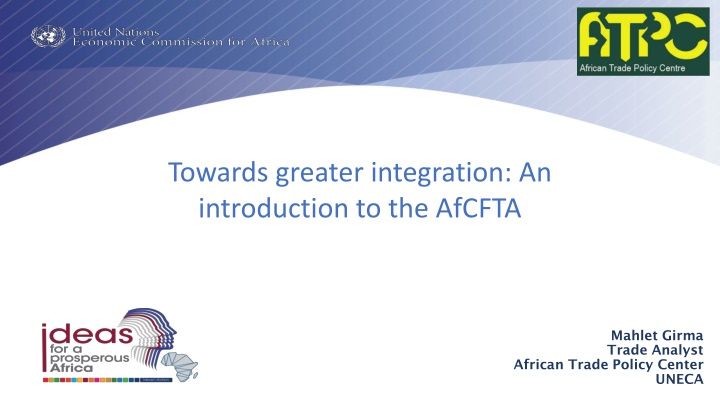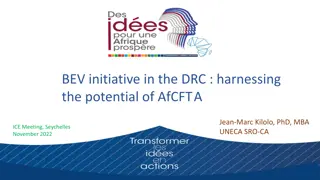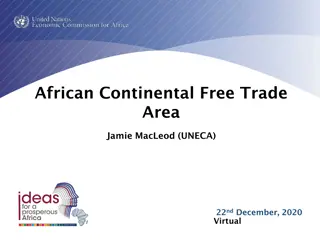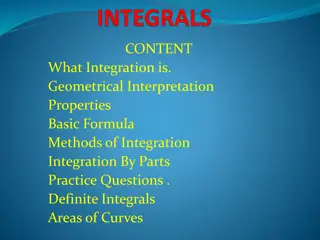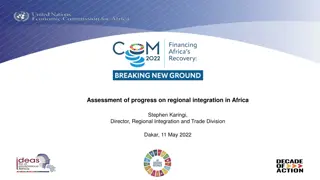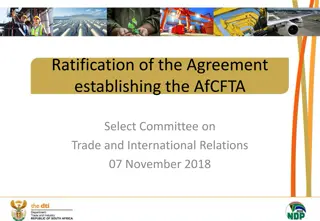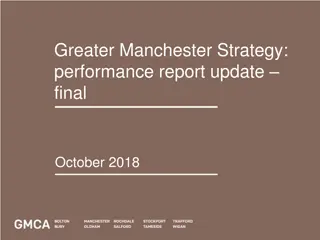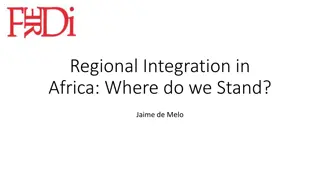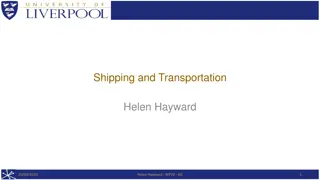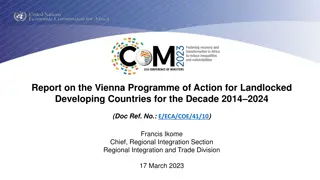Towards Greater Integration: An Introduction to the AfCFTA
An insightful introduction to the African Continental Free Trade Area (AfCFTA) highlighting its justification, scope, status, expected effects, and operational instruments. Learn about the removal of barriers, market access, job creation, and more within the framework of the AfCFTA.
Download Presentation

Please find below an Image/Link to download the presentation.
The content on the website is provided AS IS for your information and personal use only. It may not be sold, licensed, or shared on other websites without obtaining consent from the author.If you encounter any issues during the download, it is possible that the publisher has removed the file from their server.
You are allowed to download the files provided on this website for personal or commercial use, subject to the condition that they are used lawfully. All files are the property of their respective owners.
The content on the website is provided AS IS for your information and personal use only. It may not be sold, licensed, or shared on other websites without obtaining consent from the author.
E N D
Presentation Transcript
Towards greater integration: An introduction to the AfCFTA Mahlet Girma Trade Analyst African Trade Policy Center UNECA
Contents AfCFTA :Justification AfCFTA : Scope Status of the AfCFTA : Ratification and negotiations Expected effects of the AfCFTA: Empirical evidence from ECA Conclusion
AfCFTA : Why? Removal of Non-Tariff Barriers Removal of Tariffs Access to wider markets Job creation Makes investments worthwhile Coherent trade policy Drives industrialisation Expands sectors Food security Develops regional value chains
AfCFTA Framework : An overview Elimination of duties and quantitative restrictions on imports Imports shall be treated no less favourably than domestic products Elimination of non-tariff barriers Rules of Origin Cooperation of customs authorities Trade facilitation and transit Trade remedies, protections for infant industries and general exceptions Cooperation over product standards and regulations Technical assistance, capacity-building and cooperation Transparency of service regulations Mutual recognition of standards, licensing and certification of services suppliers Progressive liberalization of services sectors Service suppliers shall be treated no less favourably than domestic suppliers in liberalized sectors Provision for general and security exceptions Rules and Procedures for Settlement of Disputes within the African Continental Free Trade Area Protocol on Trade in Goods Agreement establishing the African Continental Free Trade Area (AfCFTA) Protocol on Trade in Services Protocol on Dispute Settlement Phase 2 negotiations : Intellectual property rights, Investment , Competition policy , digital trade, Women and Youth in Trade
Five Operational Instruments of the AfCFTA RULES OF ORIGIN Criteria which confer to a specific product an economic nationality . AfCFTA RoO determine the minimum level of processing of a product on the continent so that it benefits advantages provided by the Agreement ONLINE TARRIF NEGOTIATION PORTAL Tool with a view to facilitate and accelerate harmonization of data needed for negotiations and support preparation and submission of offers based on countries priorities, in accordance with the tariff liberalization schedule of the AfCFTA. NON-TARIFF BARRIERS (NTB) MECHANISM Online mechanism for notification, monitoring and elimination of NTBs under the AfCFTA. The tool is accessible via https://tradebarriers.africa/ PAN-AFRICAN PAYMENT AND SETTLEMENT PLATFORM Digital payment system that will help companies to clear and settle intra-African trade transactions for goods and services in their local currencies AFRICAN TRADE OBSERVATORY Online platform that collect, process and analyse intra- Africa trade data and other related information.
Modalities to liberalize trade in goods 3 categories of products 2 categories of countries Periods of liberalization Non-LDCs 5 years Non-sensitive products : To be fully liberalized 90% 10 years Least developed countries(LDCs) Sensitive products : To be fully liberalized over a longer period 7% Non-LDCs 10 years LDCs 13 years Non-LDCS, LDCs =>Double qualification (max 3% of tariff lines + max 10% of the average value of imports from African countries in the three years preceding the implementation of the AfCFTA) Excluded products : 3% Not liberalized, but the lists are reviewed every 5 years Criteria for sensitive or excluded products contribution to employment, revenue contribution, export earnings, food security, national security, fiscal revenue, livelihood and industrialisation products:
Understanding the modalities of liberalization Tariffs on 90 per cent of goods of AfCFTA State Parties will be reduced in equal annual installments until they are eliminated: 5 years for non-LDCs and 10 years for LDCs. i.e. A product exported from an AfCFTA State Party into a non-LDC ( if a 25% rate is applied the first year) 2021 : 25 per cent 2022 : 20 per cent 2023 : 15 per cent Reductions each year until it is traded duty-free On 7 per cent of sensitive goods, tariffs will fall within 10 years for non- LDCs and 13 years for LDCs. Tariffs will remain on 3 per cent of excluded products. .
Modes of supply : trade in services Mode of supply Description Examples Mode 1: Cross-border supply Service flows that move from the territory of one Member into the territory of another member A user in country A receives services from abroad through its telecommunications, information technology or postal delivery infrastructure Mode 2:Consumption abroad Service consumer moves into another Member s territory to obtain a service Nationals of country A travel to country B as tourists, students or patients to receive various services. Mode 3:Commercial presence Service supplier of one Member establishing territorial presence through ownership or lease of premises in another Member s territory to provide a service The service is provided in country A by a subsidiary, branch or representative office (hotel group, construction company) Mode 4:Presence of natural persons Consists of a person of one Member entering the territory of another Member to supply a service A consultant , accountants or a doctor going to another country to offer their services
Status of the AfCFTA : Ratification and negotiations
AfCFTA : Status of the negotiations Protocol on Trade in Goods 43 countries have submitted their tariff offers on goods representing 78 percent of AU Member States with consolidated submissions from 4 Customs Unions (CEMAC, ECOWAS + Mauritania, EAC and SACU) 28 of 43 Member States offers on goods for tariff liberalization have met the threshold - 90 percent of tariff lines to be fully liberalized. 87.7% of the tariff lines have agreed RoO. RECs RoO shall apply to the outstanding 12.3 percent tariff lines (on temporary bases). Protocol on Trade in Services 5 priority sectors to be liberalized: financial services, transport, telecommunications/information technology, professional services tourism 46 African countries have submitted their Services Offers. CEMAC, EAC and ECOWAS have presented consolidated services offers. Phase II issues: Investment, Intellectual Property Rights ,Competition Policy, digital trade, Women and Youth in Trade Technical committees have been established by ministers and terms of reference approved for the competition policy, intellectual property rights and investment issues. The Protocol are being developed. Digital Trade and Women and Youth Trade Protocols are at consultation level.
Expected effects of the AfCFTA: Empirical evidence from ECA
AfCFTA: Benefits centered on intra-African trade Source: ECA (https://uneca.org/sites/default/files/keymessageanddocuments/en_afcfta-infographics-11.pdf)
AfCFTA: expected impacts - intra-African exports Top 10 gains in intra-African exports by sectors, as compared to the baseline without AfCFTA in place - 2045 - US$ bn (various scenarios) Largest increases expected in exports of milk and dairy, wood and paper ,Chemical rubber , plastic and pharmaceutical products ,vehicles and transport, processed food , metals, Cereals and crops , other manufactured products, refined oils, sugar Source: UNECA
AfCFTA and Inclusion (Women and Youth) Agreement recognises the importance of gender equality and improving export capacity of informal suppliers, MSMEs, women/youth Projected increases in exports of female-dominated sectors in manufacturing and agriculture and value addition along value chains Projected increases intra-African exports in labour-intensive industries, low- skilled wages Strengthening regional value chains, customs cooperation, trade facilitation Mechanisms to address non-tariff barriers Protocol on women and youth being developed
Deliberate actions to harness the benefits of the AfCFTA Expected benefits from AfCFTA will not be automatic: Pursue ratification of Agreement Member States must Implement Agreement effectively Adopt AfCFTA Strategies & roll out Action Plans Invest in skill development and education Key role of Private Sector and development Partners Infrastructure, Services (e.g. priority sectors, logistics, health & education), Goods (e.g. Agriculture, agro- processing, manufacture) Invest in sectors of interest to them that are strategic for Africa & with potential for RVCs
Conclusion AfCFTA implementation is crucial to build diversified and stronger African economies Expected outcomes of the AfCFTA will not come overnight: integrated efforts needed at all levels for implementation Need for deliberate actionsthrough effective and integrated strategies to maximize the benefits of the Agreement while minimizing potential risks; Identification of opportunities for value chains development/integration; Identification of constraints and definition of actions to address impediments; Inclusive implementation of the AfCFTA The private sector : pivotal in the AfCFTA implementation
THANK YOU! www.uneca.org/atpc Twitter: @atpc2 Facebook: @africantradepolicycentre Email: eca-atpc@un.org girma6@un.org girma6@un.org Mahlet Girma Bekele Mahlet Girma Bekele
